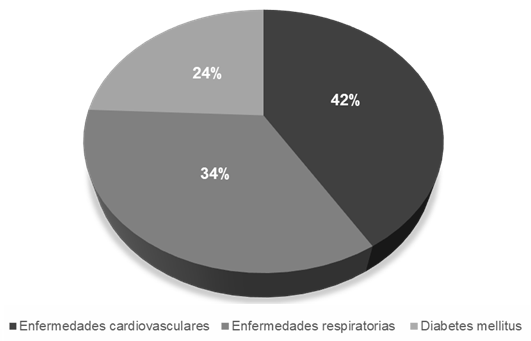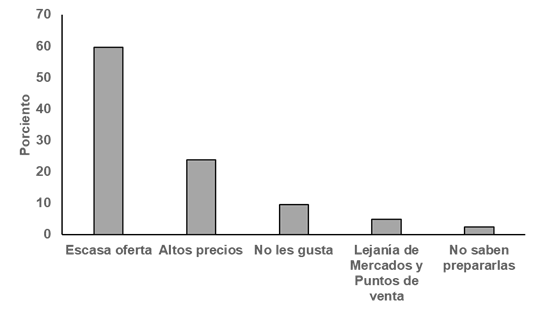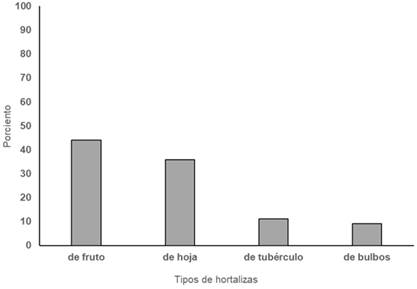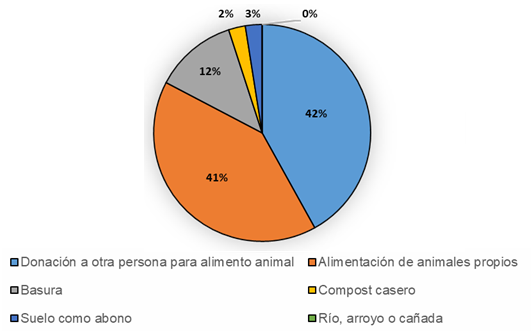Mi SciELO
Servicios Personalizados
Articulo
Indicadores
-
 Citado por SciELO
Citado por SciELO
Links relacionados
-
 Similares en
SciELO
Similares en
SciELO
Compartir
Cooperativismo y Desarrollo
versión On-line ISSN 2310-340X
Coodes vol.11 no.3 Pinar del Río sept.-dic. 2023 Epub 30-Dic-2023
Original article
Behavior regarding vegetable waste in a sample of Cuban households
1 Universidad de Sancti Spíritus "José Martí Pérez". Sancti Spíritus, Cuba.
2 Instituto de Investigaciones Fundamentales en Agricultura Tropical "Alejandro de Humboldt". La Habana, Cuba.
3 Delegación Provincial del Ministerio de la Agricultura en Sancti Spíritus. Sancti Spíritus, Cuba.
Food waste is at the center of the international debate and is reflected in the Agenda for Sustainable Development. Cuba recognizes the importance of food wastage, but does not yet have a baseline for quantifying wastage at the consumer level. The article describes the behavior regarding vegetable wastage in the domestic sector through the application of a survey in a sample of households in a Cuban municipality. A descriptive non-experimental cross-sectional quantitative research was carried out and a non-probabilistic sampling by convenience was used, where 75 households participated voluntarily. The percentage of each variable under analysis was calculated using Microsoft Excel software. The families had a total of 204 people, with a predominance of two and three members. The presence of cardiovascular diseases was evidenced, representing 42% of the non-communicable diseases reported by the respondents. In general, there is a perception of never or almost never wasting vegetables. Those left over from the meals that are discarded at the end of the meal are the most frequently discarded. It was found that 73.3% of the families waste less than one pound of vegetables per week and the most wasted vegetables are leafy vegetables, followed by fruit, bulb and tuber vegetables. The main destinations of vegetable waste are donation to another person for animal feed and for feeding one's own animals.
Key words: food waste; households; vegetables
Introduction
International attention on Food Loss and Waste (FLW) is strongly reflected in the 2030 Agenda for Sustainable Development. Reducing FLW is seen as important for improving food security and nutrition, promoting environmental sustainability and reducing production costs. However, initiatives aimed at its reduction will only be effective if they are based on a thorough understanding of the problem (Fao, 2019).
FLW represent the reduction in the quantity and/or quality of food at any stage of the supply chain. Specifically, Food Waste (FW) refers to the decrease in the mass of food at the end of the food chain at the marketing and consumption stages, i.e. associated with the behavior of sellers and consumers (Fao, 2019).
In addition to the impact on food and nutrition of the population, FW has a great impact at the economic, social and environmental level (Setti et al., 2018), making it a relevant topic of study for both academia, as well as governmental institutions.
FW prevention and reduction offers multifaceted gains for people and the planet by improving food security, impacting climate change, saving money and reducing pressure on land, water, biodiversity and waste management systems. This potential has been addressed by a lack of understanding of the true scale of the phenomenon and its negative impact. Global estimates of food waste have been based on extrapolation of data from a small number of countries, often using old data. Few governments have robust data on food waste to justify action and prioritize their efforts (UNEP, 2021).
The problem of FW is an issue that occupies political and legislative agendas around the world. It is observed that a large part of the instruments created for its regulation are articulated in the environmental framework (Hidalgo & Martín Marroquín, 2020).
Falasconi et al. (2019) state that there is international evidence that most FW occurs at the household level, mainly in developed countries. Recently, a UNEP (2021) study found that FW per capita in households is very similar in all countries, regardless of their income group, which indicates that measures against such waste are equally necessary in high, middle and low income countries. This fact differs from the arguments that have been put forward so far that FW by consumers is concentrated in developed countries and that food losses during production, transport and storage occur mainly in developing countries.
Although it is rare for an individual household to independently track its food waste, more and more organizations, both governmental and non-governmental, are beginning to take an interest in monitoring FW at the household level (CEC, 2021).
The consumption stage has been identified as critical for the wastage of different types of food and particularly for those with a high rate of spoilage, such as fruits and vegetables. International estimates indicate that the percentage of fruit and vegetable wastage at the consumption level is between 9 and 20% (Fao, 2019).
In Latin America and the Caribbean, 6 % of global food losses happen every year; the region loses and/or wastes about 15 % of its available food, of which 28 % is generated in consumption, 28 % in production, 22 % in handling and storage, 17 % in the market and distribution and 5 % in processing (Fao, 2019).
There is little information on the subject in Cuba. In 2014, losses and wastage of between 3% and 20% were reported in post-harvest fruit and vegetables in wholesale trade and local markets (Fao, 2015). Strategies have been developed in the country to solve the problem of food losses. The objective of these actions has been the implementation of short and proximity circuits for marketing, with the aim of minimizing the product's journey through the value chain and bringing producers and consumers closer together to reduce the number of intermediaries. In addition, the development of small agroindustries to transform products and training in post-harvest handling of agricultural products have been encouraged. However, the scope of these actions is insufficient at the national level and there are still problems associated with losses in the field, generated by lack of transportation, poor planning of planting, lack of quality packaging, breach of State contracts with the productive forms, lack of market infrastructure and insufficient training, among the most relevant (Vega León et al., 2015).
In relation to food loss (target 12.3 of the Sustainable Development Goals) in Cuba, estimates are made post-harvest of some agricultural products and in the production and supply chains. However, the country does not have a baseline with respect to the quantification of these losses or waste at the retail and consumer level (National Group for the Implementation of the 2030 Agenda, 2021) so it is necessary to investigate the issue.
Law 148/2022 on Food Sovereignty and Food and Nutritional Security, which implements food sovereignty plans at the municipal level in Cuba, recently entered into force and includes a title on this subject.
The article describes the behavior regarding vegetable wastage in the domestic sector through the application of a survey in a sample of households in a Cuban municipality. In this way, it constitutes a preliminary contribution to these investigations in the country, in the construction of campaigns that promote sustainable food consumption.
Materials and methods
A descriptive, non-experimental, cross-sectional, quantitative, non-experimental research was carried out. It was resorted to a non-probabilistic convenience sampling in which 75 households participated voluntarily. The selection criterion was that the households were in the urban area of the municipality. In addition, they had to meet the description of a census household (specifically a private home).
A survey was applied for data collection that contained 18 closed questions focused on the characterization of the family group, eating behavior regarding vegetable consumption and behavior with respect to vegetable waste.
The characterization of the family group included the number of people living in the household, age and sex. In addition, the presence of non-communicable chronic diseases suffered by the selected members of the nucleus, according to the incidence reported in Cuba.
The consumers' perception of the availability of vegetables in the People's Council near their homes and the characteristics of the purchase (responsible, quantity, frequency, preference and reasons for not buying) was analyzed.
It also inquired about the amount of food wasted, its frequency and causes, its destination and knowledge about the importance of waste generation.
The survey was conducted directly and online. The latter were designed through the Online Encuesta platform, which is a free online survey creator, available at https://www.onlineencuesta.com.
Quantitative totals and percentages of the variables were analyzed with Microsoft Excel software as part of the descriptive statistics.
Results and discussion
The study was conducted in the municipality of Sancti Spíritus, belonging to the province of the same name. The description of a census household (specifically a private dwelling) is reflected in Onei (2012), where a person or group of people, with or without kinship ties, who have a common budget, cook for the whole and live together on a regular basis, occupying a dwelling or part of it.
Characterization of the family group
A total of 204 people were involved, 54.90% female and 45.09% male. The characterization of the family group showed that households with 2 and 3 members (69.3%) predominated, with 54.90% of adults (36-59 years old) and older adults (60 years old and over).
Cardiovascular diseases represent the 42% of the noncommunicable diseases present (Graphic 1). Sixty percent of the families present at least one of these pathologies.
Addressing this situation is a priority for the Cuban health system due to the increase in premature deaths caused by noncommunicable diseases with respect to 2015 (National Group for the Implementation of the 2030 Agenda, 2021).
In 2016, more than 70 % of the total deaths in the world were due to non-communicable diseases; about one third of that total, was caused by cardiovascular diseases (WHO, 2018). In the Health Statistical Yearbook, offered by the Ministry of Public Health from 2011 to 2019, it is reflected that cardiovascular diseases are the main responsible for mortality in Cuba. Heart diseases, cerebrovascular diseases and diseases of the arteries, arterioles and capillary vessels, are among the top ten causes of death in the country.
Public policies should be designed and implemented to encourage popular education on nutrition through campaigns, aimed primarily at young people. In this way, the relationship between non-communicable diseases and nutrition will be understood and the consumption of vegetables will be encouraged (Rivas Estany & de la Noval García, 2021).
Eating behavior
57.3% of those surveyed believe that in their Popular Council they sell vegetables all year round. In Cuba, the humid tropical climate, characterized by high temperatures and relative humidity, hinders the diversity of vegetable species throughout the year; however, alternatives for production have been developed.
53.3% of the respondents stated that purchases are made by both women and men and 73.3% stated that they buy only what is necessary.
54.67% of consumers buy in a week 5 pounds and more, in turn, report consuming between 3 and 4 pounds (60%).
On the other hand, 60% consume vegetables with some frequency (2-4 times per week), 25.3% very frequently (5 or more days) and 17.3% state that they almost never use vegetables in their diet. It can be seen that the consumption of vegetables is low since 25.3% only report eating these foods frequently, so the importance of strengthening the urban agriculture program through actions that encourage consumption and promote the benefits in the localities should be reinforced.
It is essential to understand consumer perceptions and behaviors in relation to food waste. The influence of several factors has been studied. For example, psychographic factors, such as personality, lifestyle, interests, values, emotions and studies have been shown to influence food waste in consumers (Leal, 2021).
Among the main reasons why they almost never consume vegetables, the scarce supply (59.5 %) and high prices (23.8 %) stand out (Graphic 2).
Graphic 3 shows consumer preference by type of vegetable. It can be seen that fruit vegetables are the most preferred (44.07%), followed by leaf vegetables (35.74%).
More than half of the households surveyed preferred the following vegetables (Table 1): tomato (Solanum lycopersicum), cucumber (Cucumis sativus), onion (Allium cepa), cabbage (Brassica oleracea), green bean (Phaseolus vulgaris var. Vulgaris), bell bell pepper (Capsicum annuum), lettuce (Lactuca sativa) and leek garlic (Allium ampeloprasum var. porrum).
Table 1 Vegetables preferred by respondents
| Vegetables | % of preference |
|---|---|
| Tomato | 81,33 |
| Cucumber | 80,00 |
| Onion | 76,00 |
| Col | 70,67 |
| Bean | 70,67 |
| Chili bell pepper | 61,33 |
| Lettuce | 57,33 |
| Garlic leek | 56,00 |
Source: Own elaboration
Nutritional education prevails in these times to recognize the importance of increasing the consumption of vegetables in the Cuban population. On the other hand, there are vegetables that are little demanded due to the lack of knowledge of their consumption and nutritional contribution.
Conduct with respect to vegetable wastes
Table 2 shows the causes of vegetable wastage, as well as the frequency with which households wasted vegetables.
Table 2 Frequency of vegetable wastage and main causes of wastage
| Causes | Frequency | |||
|---|---|---|---|---|
| Never | Almost never | With some frequency | Very often | |
| Number of referring households | ||||
| Vegetables leftover from meals that are discarded at the end of the meal | 12 | 34 | 22 | 2 |
| Leftover vegetables that are stored in the refrigerator, but are later forgotten or discarded | 14 | 43 | 12 | 3 |
| Deteriorated vegetables due to poor preservation in the vegetable shelf, refrigerator or other | 22 | 30 | 13 | 2 |
| Vegetables that have been overcooked or improperly prepared | 22 | 38 | 5 | 7 |
Source: Own elaboration
In general, there is a perception of never or almost never wasting. Vegetables left over from meals at the end of the meal are the most frequently discarded. The 73.3% of the families in the study reported wasting less than one pound of vegetables per week.
Aschemann-Witzel et al. (2019) refer that leftover fresh fruits and vegetables were the category that consumers remember wasting the most. Fruits and vegetables are the most wasted food group in households (von Massow et al., 2019).
The amount of vegetable waste averaged 3.72 pounds (1.69 kg) per household for an average waste per person of 0.41 kg/week and per year would be 21.36 kg per capita. The result is lower than that shown by UNEP (2021) which estimated that in Cuba food waste in households is 72 kg/capita/year. It is worth remembering that the study only considered vegetables and not all food wasted in households.
Understanding the composition and causes of food waste can help create more effective policy interventions, so countries should consider these aspects as much as possible. In both cases, knowing the nature of the problem will facilitate the design of solutions: either reducing edible food waste or finding solutions based on circular and sustainable food systems for unavoidable waste (UNEP, 2021).
When analyzing the types of vegetables that are most wasted, leafy vegetables stand out (47.87 %), followed by fruit vegetables (32.55 %), bulb vegetables (16.38 %) and tuber vegetables (3.19 %).
On the other hand, although food waste is visualized as something negative, consumers generally face a series of barriers linked to their daily lives that prevent them from implementing practices to avoid it, such as lack of time or changes in family dynamics (Fao, 2019).
Graphic 4 shows that the main destinations of vegetable waste are donation to another person for animal feed (45.3%) and for feeding their own animals, mainly poultry and pigs (44%).
The incorporation of FW in farm animal nutrition can minimize greenhouse gases and mitigate climate change, so they would not end up in landfills (generating methane) but would provide nutrients to the animals (Albizzati et al., 2021).
This indicates that feed production, from food waste, is a viable economic option as it will replace conventional diets that occupy large areas of feed crop land and reduce environmental impact.
Also, the majority of respondents (73%) are aware of the consequences of environmental damage caused by FW. There are 26 % who have not asked themselves about the issue, a result that differs from Cáceres Rodríguez et al. (2021) who report 13.4 %.
Sixty-four percent of the surveyed population showed great concern for the generation of waste, which is an opportunity to address this problem since most of them would be willing to reduce FW.
In the Cuban context, there are other factors that highlight differences. There is a popular culture for the preservation of food and the use of those that are not consumed or commercialized by making preserves and using them as human and/or animal food. These good practices are rendered inoperative in most cases due to lack of containers, infrastructure and resources.
The study shows background information on food waste in Cuban households. This is the beginning of such studies in the country, with a view towards responsible consumption.
It should be noted that vegetable wastage in the households studied ranges from relatively medium to low, and the largest percentage is used as animal feed.
It is recognized that the consumption of vegetables in households is conditioned by the physical and economic access of families, which leads to the assumption that in other conditions their consumption could be higher, as well as the waste originated.
It is considered that horizontal education processes and public policies at the local level are required to contribute to the physical and economic access to vegetables, as well as to their conscious and responsible consumption for the health of people and the ecological health of the community by reducing the generation of waste.
Referencias bibliográficas
Albizzati, P. F., Tonini, D., & Astrup, T. F. (2021). High-value products from food waste: An environmental and socio-economic assessment. Science of The Total Environment, 755(Part 1), 142466. https://doi.org/10.1016/j.scitotenv.2020.142466 [ Links ]
Asamblea Nacional del Poder Popular. (2022). Ley de Soberanía Alimentaria y Seguridad Alimentaria y Nutricional (Ley 148). Gaceta Oficial de la República de Cuba, Edición Ordinaria No. 77. https://www.gacetaoficial.gob.cu/es/ley-148-de-2022-de-asamblea-nacional-del-poder-popular [ Links ]
Aschemann-Witzel, J., Giménez, A., & Ares, G. (2019). Household food waste in an emerging country and the reasons why: Consumer´s own accounts and how it differs for target groups. Resources, Conservation and Recycling, 145, 332-338. https://doi.org/10.1016/j.resconrec.2019.03.001 [ Links ]
Cáceres Rodríguez, P., Morales Zúñiga, M., Jara Nercasseau, M., Huentel Sanhueza, C., Jara Vargas, C., & Solís Bastías, Y. (2021). Encuesta sobre comportamiento familiar frente al desperdicio de alimentos y determinación del costo nutricional de este en una muestra de hogares en chile: Resultados de un estudio piloto. Revista Española de Nutrición Humana y Dietética, 25(3), 279-293. https://doi.org/10.14306/renhyd.25.3.1242 [ Links ]
CCA. (2021). Por qué y cómo cuantificar la pérdida y el desperdicio de alimentos - Apéndice A. Métodos. Comisión para la Cooperación Ambiental. http://www.cec.org/es/publications/por-que-y-como-cuantificar-la-perdida-y-el-desperdicio-de-alimentos-apendice-a-metodos/ [ Links ]
Falasconi, L., Cicatiello, C., Franco, S., Segrè, A., Setti, M., & Vittuari, M. (2019). Such a Shame! A Study on Self-Perception of Household Food Waste. Sustainability, 11(1), 270. https://doi.org/10.3390/su11010270 [ Links ]
Fao. (2015). Pérdidas y desperdicios de alimentos en América Latina y el Caribe. Organización de las Naciones Unidas para la Alimentación y la Agricultura. https://www.fao.org/documents/card/en?details=I4655S/ [ Links ]
Fao. (2019). El estado mundial de la agricultura y la alimentación 2019: Progresos en la lucha contra la pérdida y el desperdicio de alimentos. Organización de las Naciones Unidas para la Alimentación y la Agricultura. https://doi.org/10.4060/CA6030ES [ Links ]
Grupo Nacional para la Implementación de la Agenda 2030. (2021). I Informe Nacional Voluntario Cuba 2021. Ministerio de Economía y Planificación. https://www.mep.gob.cu/sites/default/files/Documentos/Archivos/INV%20Cuba%20Agenda%202030_NNUU%202021.pdf [ Links ]
Hidalgo, D., & Martín Marroquín, J. M. (2020). El desperdicio de alimentos, un problema global. IndustriAmbiente: gestión medioambiental y energética, (29), 28-33. https://dialnet.unirioja.es/servlet/articulo?codigo=7516528 [ Links ]
Leal, M. (2021). Desperdicio de alimentos en el hogar. Red alimentaria FoodTech. https://www.redalimentariafoodtech.com/nota/479492-desperdicio-de-alimentos-en-el-hogar-4 [ Links ]
Onei. (2012). Censo de Población y Viviendas. Oficina Nacional de Estadística e Información. http://www.onei.gob.cu/node/1140 [ Links ]
Pnuma. (2021). Índice de desperdicio de alimentos 2021. Programa de las Naciones Unidas para el Medio Ambiente. http://www.unep.org/es/resources/informe/indice-de-desperdicio-de-alimentos-2021 [ Links ]
Rivas Estany, E. B., & de la Noval García, R. (2021). Obesidad en Cuba y otras regiones del Mundo. Consideraciones generales y acciones nacionales de prevención. Anales de la Academia de Ciencias de Cuba, 11(1), 887. https://revistaccuba.sld.cu/index.php/revacc/article/view/887 [ Links ]
Setti, M., Banchelli, F., Falasconi, L., Segrè, A., & Vittuari, M. (2018). Consumers' food cycle and household waste. When behaviors matter. Journal of Cleaner Production, 185, 694-706. https://doi.org/10.1016/j.jclepro.2018.03.024 [ Links ]
Vega León, M., Gordillo Orduño, M. C., & Fernández Hernández, Y. O. (2015). Manual de Buenas Prácticas Agrícolas en la producción orgánica de hortalizas. Asociación Cubana de Técnicos Agrícolas y Forestales. https://isbn.cloud/9789597210900/manual-de-buenas-practicas-agricolas-en-la-produccion-organica-de-hortalizas/ [ Links ]
von Massow, M., Parizeau, K., Gallant, M., Wickson, M., Haines, J., Ma, D. W. L., Wallace, A., Carroll, N., & Duncan, A. M. (2019). Valuing the Multiple Impacts of Household Food Waste. Frontiers in Nutrition, 6(143). https://doi.org/10.3389/fnut.2019.00143 [ Links ]
WHO. (2018). Noncommunicable diseases country profiles 2018. World Health Organization. https://www.who.int/publications-detail-redirect/9789241514620 [ Links ]
Received: May 18, 2023; Accepted: December 12, 2023











 texto en
texto en 






